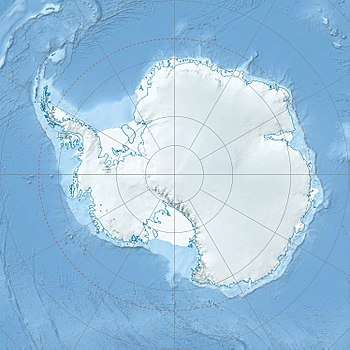Pensacola Mountains
The Pensacola Mountains are a large group of mountain ranges of the Transantarctic Mountains System, located in the Queen Elizabeth Land region of Antarctica.
| Pensacola Mountains | |
|---|---|
 | |
| Highest point | |
| Peak | England Peak[1] |
| Elevation | 2,150 m (7,050 ft) |
| Coordinates | 82°37′S 52°49′W |
| Dimensions | |
| Length | 450 km (280 mi) |
| Area | 86,850 km2 (33,530 sq mi) |
| Geography | |
 Location in Antarctica | |
| Continent | Antarctica |
| Region | Queen Elizabeth Land |
| Range coordinates | 84°2′S 61°22′W |
| Parent range | Transantarctic Mountains |
Geography
They extend 450 km (280 mi) in a NE-SW direction. Subranges of the Pensacola Mountains include: Argentina Range, Forrestal Range, Dufek Massif, Cordiner Peaks, Neptune Range, Patuxent Range, Rambo Nunataks and Pecora Escarpment. These mountain units lie astride the extensive Foundation Ice Stream and Support Force Glacier which drain northward to the Ronne Ice Shelf.[2]
- Naming
Discovered and photographed on January 13, 1956 in the course of a transcontinental nonstop plane flight by personnel of US Navy Operation Deep Freeze I from McMurdo Sound to Weddell Sea and return. Named by US-ACAN for the U.S. Naval Air Station, Pensacola, Florida, in commemoration of the historic role of that establishment in training aviators of the U.S. Navy. The mountains were mapped in detail by USGS from surveys and US Navy air photos, 1956–67.[2]
Geology
The Pensacola Mountains were originally continuous with the Ventana Mountains near Bahía Blanca in Argentina, Cape Fold Belt in South Africa, the Ellsworth Mountains (West Antarctica) and the Hunter-Bowen orogeny in eastern Australia.
The Ordovician-Devonian Neptune Group rests unconformably on a Cambrian succession, and is overlain disconformably by the Dover Sandstone of the Beacon Supergroup. Within the Neptune Group is the Brown Ridge Conglomerate, Elliott Sandstone, Elbow Formation, and the Heiser Sandstone.[3]
Features
Geographical features include:
Neptune Range
Williams Hills
Schmidt Hills
Other features
- Baker Ridge
- Barnes Icefalls
- Bennett Spires
- Berquist Ridge
- Brown Ridge
- Childs Glacier
- Drury Ridge
- Elbow Peak
- Elliott Ridge
- Elmers Nunatak
- Final Rock
- Foundation Ice Stream
- Gale Ridge
- Gambacorta Peak
- Hannah Ridge
- Heiser Ridge
- Hill Nunatak
- Hinckley Rock
- Hudson Ridge
- Jones Valley
- Kaminski Nunatak
- Kinsella Peak
- Loren Nunataks
- Madey Ridge
- Meads Peak
- Median Snowfield
- Miller Valley
- Mount Bragg
- Mount Cowart
- Mount Dover
- Mount Ege
- Mount Feldkotter
- Mount Hawkes
- Mount Kaschak
- Mount Moffat
- Neith Nunatak
- Nelson Peak
- Patrick Nunatak
- Ramsey Cliff
- Rivas Peaks
- Seay Nunatak
- Seely Ridge
- Serpan Peak
- Spanley Rocks
- Torbert Escarpment
- Washington Escarpment
- Webb Nunataks
- West Prongs
- Wiens Peak
Forrestal Range
- Ackerman Nunatak
- Beiszer Nunatak
- Burmester Dome
- Butler Rocks
- Camp Spur
- Chambers Glacier
- Coal Rock
- Creaney Nunataks
- Crouse Spur
- Dyrdal Peak
- Erlanger Spur
- Fierle Peak
- Ford Ice Piedmont
- Franko Escarpment
- Gabbro Crest
- Grob Ridge
- Haskill Nunatak
- Henderson Bluff
- Herring Nunataks
- Hodge Escarpment
- Huie Cliffs
- Kent Gap
- Kovacs Glacier
- Lance Rocks
- Larson Nunataks
- Magnetite Bluff
- Mathis Spur
- May Valley
- McCauley Rock
- Median Snowfield
- Mount Hook
- Mount Hummer
- Mount Malville
- Mount Mann
- Mount Stephens
- Ray Nunatak
- Ritala Spur
- Ronald Rock
- Sallee Snowfield
- Sheriff Cliffs
- Skidmore Cliff
- Sorna Bluff
- Support Force Glacier
- Thompo Icefall
- Vanguard Nunatak
- Vigen Cliffs
Patuxent Range
Anderson Hills
Thomas Hills
Other features
- Bennett Spires
- Bessinger Nunatak
- Blake Rock
- Brazitis Nunatak
- Brooks Nunatak
- Brown Ridge
- DesRoches Nunataks
- DeWitt Nunatak
- Foundation Ice Stream
- Houk Spur
- Lawrence Nunatak
- Lekander Nunatak
- Mackin Table
- Mount Bragg
- Mount Campleman
- Mount Dover
- Mount Dumais
- Mount Wanous
- Mount Weininger
- Natani Nunatak
- Patuxent Ice Stream
- Patuxent
- Pecora Escarpment
- Phillips Nunatak
- Plankington Bluff
- Postel Nunatak
- Snake Ridge
- Stout Spur
- Sullivan Peaks
- White Nunataks
Argentina Range
Schneider Hills
Panzarini Hills
Other features
Cordiner Peaks
Rambo Nunataks
Pecora Escarpment
Dufek Massif
Boyd Escarpment
Other features
- Alley Spur
- Aughenbaugh Peak
- Brown Nunataks
- Cairn Ridge
- Carlson Buttress
- Clemons Spur
- Clinton Spur
- Czamanske Ridge
- Davis Valley
- Edge Glacier
- Enchanted Valley
- England Peak
- Ford Ice Piedmont
- Forlidas Pond
- Forlidas Ridge
- Foundation Ice Stream
- Frost Spur
- Hannah Peak
- Jaburg Glacier
- Jaeger Table
- Kelley Spur
- Kistler Valley
- Lewis Spur
- Neuburg Peak
- Nutt Bluff
- Petite Rocks
- Preslik Spur
- Pyroxenite Promontory
- Rautio Nunatak
- Sallee Snowfield
- Sapp Rocks
- Spear Spur
- The Organ Pipes (Antarctica)
- Tranquillity Valley
- Walker Peak
- Welcome Pass
- Worcester Summit
- Wujek Ridge
Other Pensacola Mountains features
Further reading
References
- "Pensacola Mountains". Peakbagger. Retrieved 23 May 2017.
- "Pensacola Mountains". Geographic Names Information System. United States Geological Survey. Retrieved 2004-11-03.
- Laird, M.G. (1991). Thomson, M.R.A.; Crame, J.A.; Thomson, J.W. (eds.). Lower-mid-Palaeozoic sedimentation and tectonic patterns on the palaeo-Pacific margin of Antarctica, in Geological Evolution of Antarctica. Cambridge: Cambridge University Press. p. 179. ISBN 9780521372664.